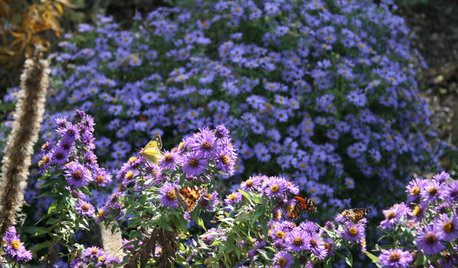There is a great thread by iamabirdnut on this forum and questions came up about the A. fimbriata vine. I thought I'd post this photo and my experience with growing the little vine. Another forum member kindly shared seed with me two years ago and I'm so pleased to grow this little plant.
The photo below will show the size of the leaves in relationship to English Ivy. The largest of my leaves grow maybe 2-3 inches across and the little vines behave more like a ground cover. Each little vine appears to mature at maybe 20 inches or so in length, the leaves are quite tender for the baby cats but they can munch through the little vines quite quickly. The little vines do recover, sprouting new growth from the tuberous root.
This is the first year I've grown this plant in ground and with only early morning dappled sun and then high shade from the A. tomentosas, which is growing on a tall trellis above this planting, and regular watering, they are doing great (much better than when I attempted to grow them in hanging baskets). They are currently planted in rich loamy soil in a raised bed. I've found them easy to germinate from seed and I've read they will reseed themselves, adding to their colony. I discovered three new little plants growing out of the pine mulch in my shade garden this summer. This is the spot where I had the baskets sitting last summer, after I realized they couldn't take our sun here in Arkansas and moved them to my shade garden.
Sherry, I bet they would do well in dappled shade in your garden. They're a pretty plant, too, with the white veins providing some interest among the green of a garden. The little blooms are typical pipevine blooms and when they produce seed pods, the pods look like little watermelons hanging on the tiny vines. Each little seed pod contains quite a few seeds. In my experience, the vines will not twine themselves around a trellis, they seem to prefer to sprawl along the ground and so far, I've seen no rooting along the length of the little vines. A couple of days ago, I placed a rock on top of a section of one little vine, just to see if it would evently root at a leaf node. I've read they can be rooted from cuttings but I've never tried.
The tiny blooms at the bottom of the photo are: Wishbone Flower - Clown Mix (Torenia fournieri), not blooms of the little vine.
~Mary
A. fimbriata vines (aka White Veined Hardy Dutchman's Pipevine) growing with English Ivy. Zone 7-9
{{gwi:523154}}











MissSherry
Mary LeekOriginal Author
Related Professionals
Ferndale Landscape Architects & Landscape Designers · Quincy Landscape Contractors · Wickliffe Landscape Contractors · Columbia Fence Contractors · Arcadia Fence Contractors · Cherry Hill Fence Contractors · Cutler Bay Fence Contractors · Glenview Fence Contractors · Laguna Hills Fence Contractors · Short Pump Fence Contractors · Bellwood Window Contractors · Edmonds Window Contractors · Enumclaw Window Contractors · Palm River-Clair Mel Window Contractors · Wilmette Window Contractorslucas_tx_gw
Mary LeekOriginal Author
bettyd_z7_va
Mary LeekOriginal Author
bettyd_z7_va
imabirdnut
Mary LeekOriginal Author
MissSherry
klflorida
bettyd_z7_va
klflorida
Mary LeekOriginal Author
bettyd_z7_va
tomatoworm59
klflorida
Mary LeekOriginal Author
mechelle_m
Mary LeekOriginal Author
butterflymomok
Mary LeekOriginal Author
imabirdnut
Mary LeekOriginal Author
christie_sw_mo
bethpierce77
Liz
roselee z8b S.W. Texas
bethpierce77
Mary LeekOriginal Author
bethpierce77
Mary LeekOriginal Author